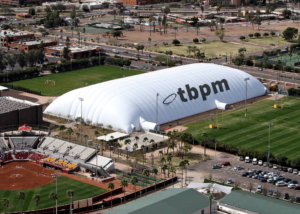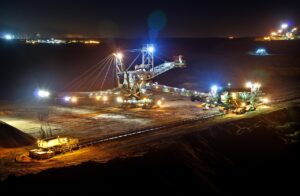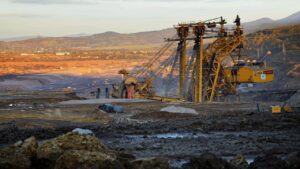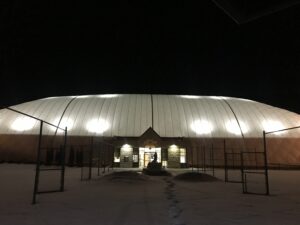In recent years, the sports industry has been making significant strides towards sustainability, with renewable energy implementation leading the charge. This shift isn’t just about being eco-friendly; it’s a smart business move that’s reshaping the future of sports infrastructure, including traditional stadiums and innovative climate-controlled air supported domes.
The Power Play: Why Renewable Energy?
Sports facilities, from massive stadiums to versatile air domes, are energy-intensive, consuming vast amounts of electricity for lighting, climate control, and
operations. By turning to renewable energy sources, these venues are:
- Reducing their carbon footprint
- Cutting long-term energy costs
- Enhancing their brand image
- Complying with stricter environmental regulations
Solar Success Stories
Solar power has emerged as a favorite among facility managers:
- Estadio Nacional (Brazil): This World Cup venue boasts a 2.5 MW solar array on its roof.
- Lincoln Financial Field (USA): Home to the Philadelphia Eagles, it generates about 40% of its annual electricity from solar panels.
- Johan Cruijff ArenA (Netherlands): Uses a combination of solar panels and energy storage systems.
Climate-controlled Air Supported Domes: A Game Changer
Air supported domes are increasingly adopting renewable energy solutions:
- Energy Efficiency: These structures require less energy for heating and cooling due to their excellent insulation properties.
- Solar Integration: Some air domes incorporate photovoltaic fabrics or solar panels on adjacent structures to power their operations.
- Seasonal Flexibility: The ability to install and remove these domes seasonally allows for optimized energy use throughout the year.
Case Study: A multi-sport air dome facility in Canada uses a combination of geothermal heating and solar panels to maintain a comfortable environment year-round, even in harsh winter conditions.
Wind Power in the Game
While less common, wind turbines are making their mark:
- Forest Green Rovers (UK): This League Two club plans to build a stadium powered entirely by renewable energy, including wind power.
- Ecopark Stadium (UK): Hull City’s proposed new home aims to incorporate wind turbines into its design.
Hybrid Systems: The Best of Both Worlds
Some facilities are opting for a combination of renewable sources:
- Mercedes-Benz Stadium (USA): Home to the Atlanta Falcons, it uses a mix of solar panels and fuel cells.
- CenturyLink Field (USA): The Seattle Seahawks’ stadium combines solar power with waste-to-energy systems.
Beyond Electricity: Comprehensive Energy Strategies
Leading sports facilities are looking at energy holistically:
- Energy-efficient LED lighting systems
- Smart building management systems for optimized energy use
- Improved insulation and natural ventilation to reduce HVAC demands
Air domes, in particular, benefit from:
- Advanced fabric materials that enhance insulation
- Efficient air circulation systems that maintain consistent temperatures
- Translucent materials that reduce the need for artificial lighting during daytime
The Financial Upside
While initial investments can be substantial, the long-term benefits are clear:
- Reduced operational costs
- Protection against rising energy prices
- Potential revenue from selling excess energy back to the grid
- Access to green energy incentives and tax breaks
For air supported domes, the energy savings can be even more significant due to their efficient design and lower overall energy requirements.
Overcoming Challenges
Implementing renewable energy in sports facilities isn’t without hurdles:
- High upfront costs
- Intermittent nature of renewable sources
- Retrofitting existing structures
- Balancing energy production with aesthetic concerns
For air domes, specific challenges include:
- Integrating renewable systems without compromising the dome’s structural integrity
- Ensuring sufficient power storage for continuous operation
However, innovative financing models and technological advancements are helping to address these issues.
The Future is Bright (and Green)
As technology improves and costs decrease, we can expect to see:
- More facilities achieving net-zero energy status
- Integration of advanced energy storage solutions
- Increased use of microgrid systems for energy resilience
- Greater collaboration between sports venues and local communities on energy initiatives
For air supported domes, future innovations may include:
- Self-generating energy fabrics
- Advanced thermal management systems
- Integration with smart city infrastructure for optimized energy use
Conclusion
The implementation of renewable energy in modern sports facilities, including climate-controlled air supported domes, is more than just a trend; it’s a fundamental shift in how we approach sports infrastructure. As more venues embrace these technologies, they’re not only scoring points for the environment but also setting a powerful example for other industries to follow.
For sports organizations looking to stay ahead of the game, investing in renewable energy isn’t just an option—it’s quickly becoming a necessity. Whether it’s a traditional stadium or an innovative air dome, facilities powered by clean energy will likely become the new standard, transforming the sports experience both on and off the field while contributing to a more sustainable future.
AI-Assisted Content Disclaimer
This article was created with AI assistance and reviewed by a human for accuracy and clarity.












